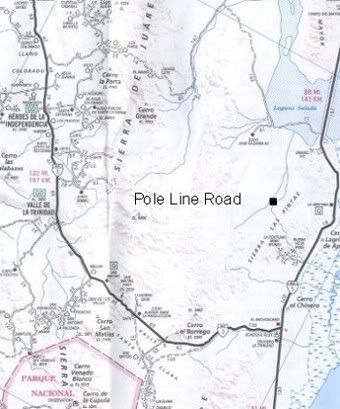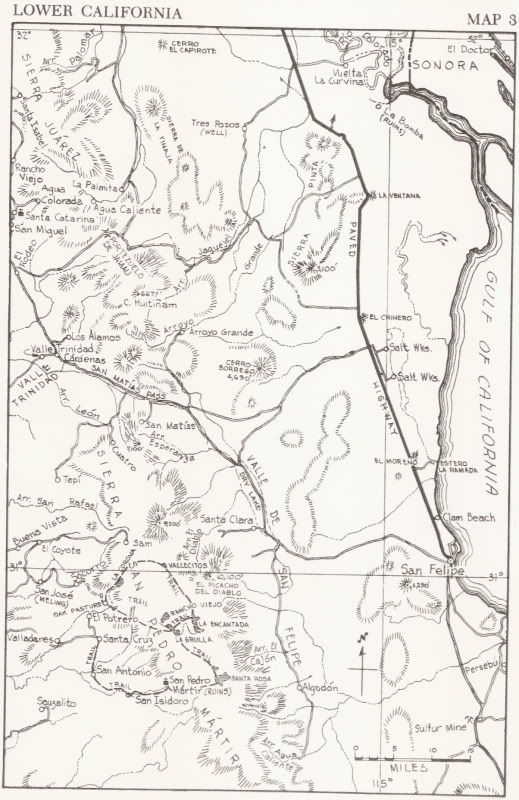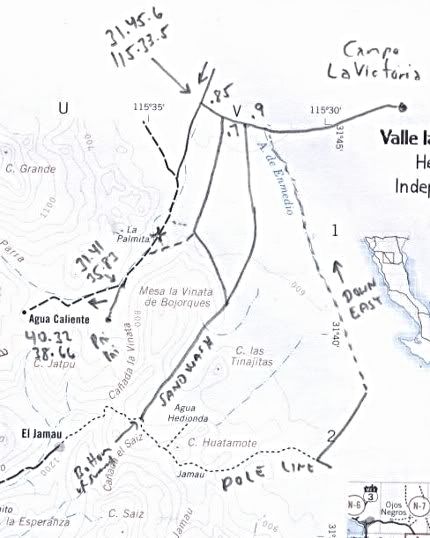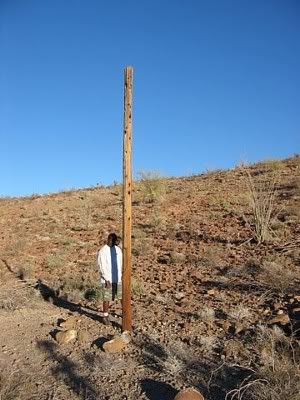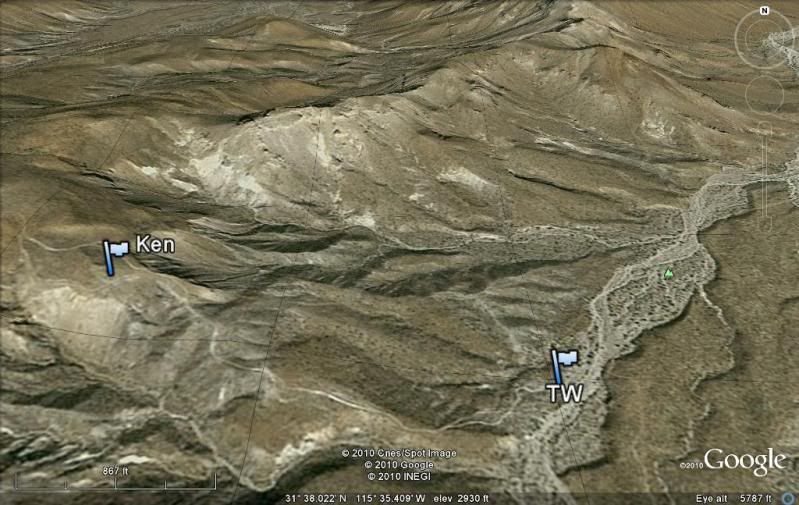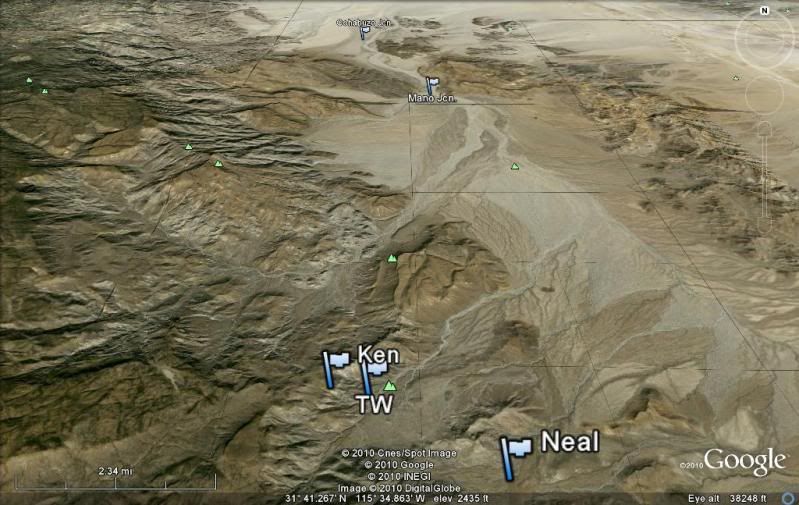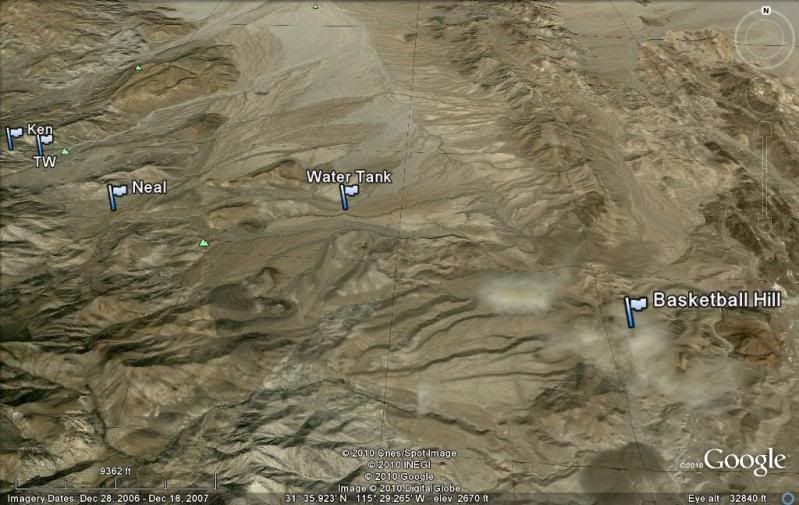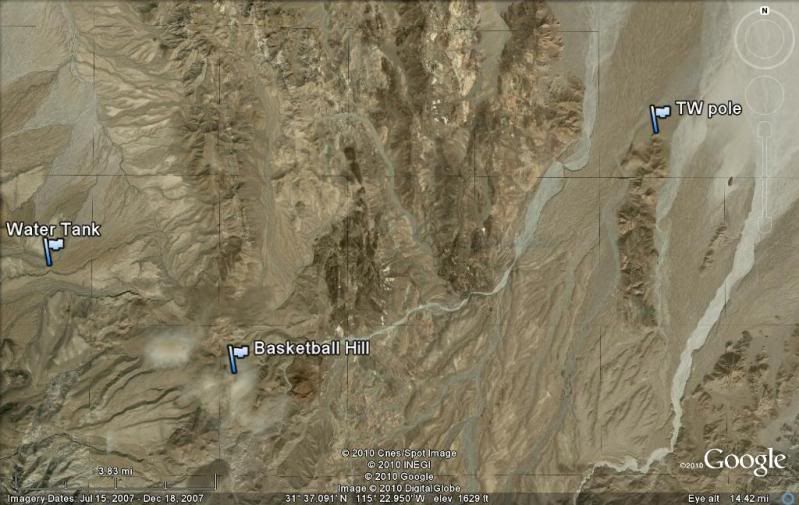Originally posted by 56MM#
The date was Saturday, November 6th. I had planned to go up El Mano Canyon for the fifth time in the past 12 years but ended up in the area further
south. In the process we found a road that cuts through to Hwy 3 and can be easily negotiated by a slightly modified 4x4.
Vehicle was a 1995 Toyota 4-Runner with a mild suspension lift, 32-inch BFG Mud Terrains, rear locking differential, skid plates and two spare tires.
Of particular note was that I had a small but manageable leak in my brake manifold. As the leak had not gotten any worse over the past few months, I
made the conscious decision to take my truck in this state and carry two 16-oz cans of brake fluid. As luck would have it, the leak got slowly worse,
necessitating master cylinder topoffs every two hours or so. Additionally, the brake pedal got spongier and spongier as the trip progressed.
I was accompanied by two friends, one of whom is from the UK. His enthusiasm and infectious optimism made a trip filled with hiccups very enjoyable.
We left San Diego around 6:30 am Saturday morning. After filling the truck with gas in Calexico and getting three extra gallons (just in case), we
crossed into Mexicali around 8:30 am. The wait to get into Mexico was around 15 minutes. Getting through Mexicali was relatively painless, despite
it being primarily stop and go until one is well west of the city on Hwy 2.
The area around the Guadalupe Canyon turnoff is now popular with dirt bikers and other off-roaders. There is a small grandstand just south of Hwy 2.
We also saw numerous dirt bikes along the first five miles of the road to Guadalupe Canyon.
Our original intent had been to go west up El Mano Canyon then south to Hwy 3. For whatever reason (likely my inattention to the map), we took the
wrong road at the Guadalupe Canyon fork and headed towards El Palomar. This cost us at least 1-1/2 hours. After getting back on the main road east
of El Palomar, we continued south.
Several miles south of where we rejoined the main road, the right rear tire began leaking air. It took about 30 seconds for the tire to go flat. The
puncture was between treads and was a clean round hole with several of the steel belts broken. Given the size of the hole and the fact that I only
had tire plugs and super glue (did not have tire plug cement in my boonie box), I chose to plug the hole but not reinstall the tire, going with one of
our two spares instead. After this short delay and pictures we continued south.
I suspect the flat was caused by a spike strip or similar device. This is based on:
- Round and regular shape of the puncture
- Broken steel belts visible to the eye
- Discussion of the puncture with someone who is very knowledgeable of tires
- Knowledge that the ranchers in Baja California who live along race routes strongly dislike off roaders and have been known to deploy tire-puncturing
devices
Our next unexpected event was coming upon a group of eight mountain bikers, none of whom were carrying much equipment. It was odd to see this so far
from pavement. Around 15 minutes later, we came upon two SUVs, which turned out to be chase vehicles. The front driver asked if we had seen any
bikers, to which we responded yes.
We learned that this group was from Ensenada and had come from Hwy 3. The driver stated that Hwy 3 was 80 km south. I immediately began thinking
that there was a way through, despite the Baja Almanac not depicting any road past Agua Caliente. I decided to take the risk, skip El Mano Canyon and
continue south instead. We had around 2-1/2 hours of daylight remaining.
As we drove south, the road appeared to be entering a box canyon, causing me great concern. Adding to the stress was the fact that we had only a half
tank of gas plus one gallon left in the gas can. If we were to turn around now, we would barely make it back to Mexicali, well after dark. Upon
closer examination of the terrain we saw a road cut into the side of a mountain and immediately felt a great sense of relief.
The higher we climbed the more confident we got about making it to Hwy 3. But darkness was closing in. Just before the summit, we reached a fork.
Going left would take us up a very steep grade to the top of a mountain. Going right it appeared that the road wound around the mountain. Both of
the Americans wanted to go right. My British friend insisted on running up to the top of the mountain to scope the area. Despite the sense of
urgency to make as much progress as possible before darkness, I decided to stop while he scouted ahead. 15 minutes later he came back and reported
that the road over the mountain was the only way to the other side of the range where we would hopefully pick up Hwy 3. Taking the low road to the
right would have taken us back to where we came from. Good thing us Yanks listened. Otherwise, darkness would have shut us down for the night.
The stretch to the top of the mountain was short but easily the most difficult conditions we had encountered all day. It was a slow steep climb over
loose rocks in 4LO 1st gear. By the time we reached the top it was dark enough that we could only see a few fixed lights in the distance from what we
suspected were Heroes de la Independencia and Leyes de Reforma. There were no moving headlights to identify Hwy 3.
We spent the next several hours flailing around in the dark on roads of varying quality, looking for Hwy 3. For the first time this trip I turned on
the GPS. Even with GPS, my brain was not processing all the information. There were many more roads than depicted on the map, something that should
surprise no one with any Baja California backcountry experience. After maybe 1-1/2 hours of going in circles and almost driving into at least one
deep washout, my brain told me that if I steered the truck on headings between 170 and 290 degrees true we would eventually reach Hwy 3. It was not
long before we came upon a well-graded dirt road that, surprise surprise, led to the pavement.
Except for nursing the brakes and using the transmission to slow down, the remainder of the trip was uneventful. We filled up with gas and aired up
the tires in Ensenada. It was nearly midnight. Any ideas about stopping at La Fonda for a nice dinner and comfortable bed were out the window. We
got to Tijuana after 1 am and decided to get a room at the Pueblo Amigo Hotel, which is right next to the San Ysidro border crossing, rather than wait
in line in our exhausted states and extend the trip that many more hours.
We checked out of the hotel around 6:50 am, were in line by 7 am, and were back in the U.S. by 8 am.
Despite all the problems, this was a great trip. I passed through an area I had wanted to explore for many years (Agua Caliente and El Jamau) but was
never willing to devote the required two days necessary to do so. Additionally, it is a great pleasure to go four wheeling with someone who really
appreciates everything about Baja California, including many of the things most of us take for granted. There is no place like Baja California in the
UK, Europe or anywhere else in the world for that matter. Those of us who live in the San Diego area are truly blessed to have such an amazing place
right at our doorstep.
Lessons reinforced from this trip:
- Always inventory your boonie box before each trip. Baja California, even close to the border, has some remote areas where help can be a day or more
away. This isnít Anza-Borrego. A punctured tire without tire plug cement or super glue will likely remain a punctured tire.
- Donít go to Baja with a slow leak of any type of fluid. In our case, the leak in the brake manifold got much worse out on the trail, despite
seeming to have reached a steady manageable state where it didnít get any worse for several months prior.
- Navigation at night, even with GPS, a good map and KC Highlighters, is very difficult. There is no substitute for light and 360-degree terrain
awareness.
- Days are much shorter in the period between the Fall and Spring solstices. I had planned on around 11.5 hours of light but didnít plan for things
like changing a tire, the occasional wrong turn and excited passengers who want to stop for pictures. The sense of urgency increases exponentially
this time of year after 3 pm as the sun gets lower the sky. Allow 20% more time than what you calculate on pre-trip planning.
- Crossing at San Ysidro at 8 am on Sunday morning took 59 minutes. This beats two or three hours, which is the norm afternoons, evenings and weekday
mornings. Consider structuring the trip to cross on a weekend morning. La Fonda is a great place to get a great dinner, shower, comfortable bed and
continue the celebration before going home (every moment in Baja California should be celebrated).
I hope to do this trip again no earlier than March 2011 when there will be 12+ hours of daylight. Perhaps a two-day trip crossing in Tecate, driving
through Laguna Hanson, coming down El Mano Canyon, and camping overnight in the area of Agua Caliente would be the best way to fully explore this
lovely and remote area of northern Baja California. Additionally, I really want to map this route from the area south of the El Mano Canyon turnoff
to Hwy 3.
If any of you have done this route, please post the coordinates of the area between the El Mano Canyon turnoff and Hwy 3. |



 )
)

